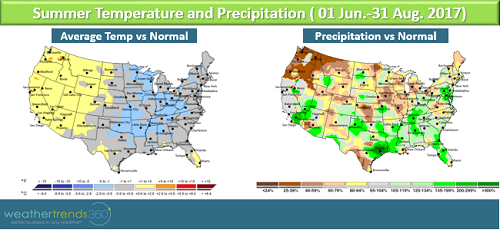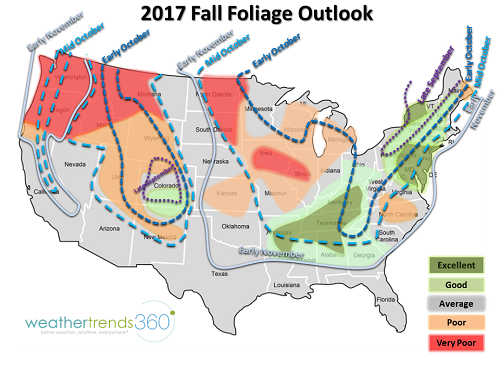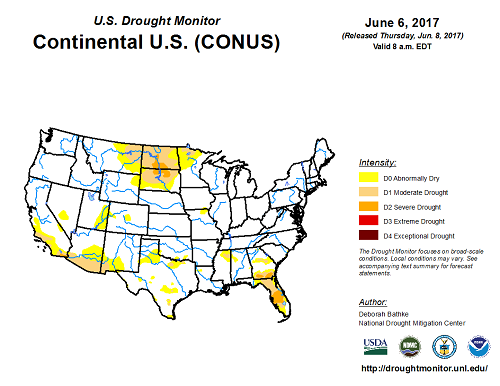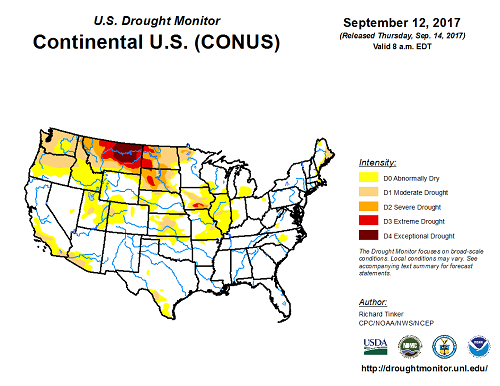2017 Fall Foliage Outlook with Maps
Business
The weather has kept us on our toes this season with major hurricanes, wildfires, and flip-flopping weather patterns. Meteorologists are exhausted. So it is with much pleasure that we write about something less stressful today, Fall Foliage. It's been on the back-burner of topics so far this season but with the early cool weather we've had in the Northeast, we'll be in peak foliage before we know it, so let's get on with it!
Northeast
The Northeast has had a nearly perfect weather set-up for stunning color this season, but don't be surprised if that color peaks a bit earlier than usual. This past summer was not overly hot with warm temperatures trending closer to normal, as seen in the temperature map below. Precipitation was ample, especially across eastern Pennsylvania, New Jersey, and Maryland, and this was the wettest summer in 26+ years for the Northeast as a whole.
Warm and wet weather set the stage for healthy tree and leaf development. The other piece of the weather pie that came together was a cool and cloudy late August and early September. In fact, the first half of September was the coolest such time period in 26+ years for the Northeast and precipitation was the greatest in 5 years. Cool, but not freezing weather is favorable for robust color. Persistently cloudy weather during the first half of September helped to slow down the production of chlorophyll, and even down in southeastern Pennsylvania, we were already starting to see leaves turn color by mid-September (peak is usually late October).

While the majority of the Northeast should see fantastic color, there are some areas where the color may be less spectacular and leaves may drop before getting a chance to display vibrant colors. Parts of northern and coastal New England have seen drought conditions grow over the summer, particularly eastern Maine. Drought may cause less than spectacular viewing in this area as leaves drop before developing any brilliant color.
Best Foliage: Pocono Mountains in Pennsylvania in early to mid October

(The map above shows expected condition of the foliage . Lines depict approximately when the peak foliage will occur.)
Southeast
Fall foliage should also put on a nice display in the Southeast where weather conditions have been fairly favorable. Like the Northeast, temperatures this past summer were closer to normal for the region as a whole and precipitation was plentiful as this was the 3rd wettest summer in 26+ years for the region. Also like the Northeast, the first half of September has been the coolest in 26+ years, but it's been a bit wetter as this has been the wettest in 26+ years for the region.
Like the Northeast, growing drought conditions may prevent brilliant foliage across parts of the region. This includes parts of central North Carolina and Virginia. But drought isn't the only concern for the foliage in the Southeast. Late last year, recall that devastating wildfires burned across parts of the popular tourist Gatlinburg area. The loss of trees and damage to other trees from the fires will likely cause some eye sores when it comes to fall foliage. Also consider that recent Hurricane Irma moved far inland as a tropical storm bringing strong, damaging winds as far as Atlanta, GA. Strong wind can strip leaves from trees prematurely which could dampen the overall fall foliage when it arrives late in October or early November.
Best Foliage: Tennessee Valley in mid-October
Midwest
Leaf peeping in the Midwest will not be as spectacular as their eastern neighbors, however, there will be some bright spots. far Eastern parts of the region will see the best foliage, while western areas will not be as spectacular. The eastern Great Lakes region has experienced similar weather patterns to the Northeast, hence, the prospect for a fantastic fall foliage this year. The summer was characterized by near normal temperatures although precipitation wasn't nearly as plentiful as it was in the Northeast. The first half of September has been the coldest in 26+ years.
While far eastern portions of the Midwest should see some brilliant color, the rest of the region isn't looking as favorable. Although temperatures over the summer were closer to normal in the western portion of the Midwest, precipitation was much below normal with growing drought conditions, particularly from Iowa to Missouri and Illinois. Comparing the drought maps below from early summer (June) to the most recent (September) clearly shows the areas that experienced drought growth. Although the first half of September has been relatively cool for the region, precipitation is still lacking. Expect leaves in the western Midwest to drop with lackluster color due to the lack of moisture all summer long.


Best Foliage: Ohio in early to mid-October
Northern Plains/ Rocky Mountains
Extremely unfavorable weather conditions this past summer and continuing into the first half of September have set up the Northern Plains and Northern Rocky Mountains for fall foliage disappointment. Above normal temperatures and below normal precipitation this past summer resulted in a rapidly deepening drought across the region. Hot conditions continued into the first half of September but have since cooled down significantly. However, the damage is already done with leaves likely to drop without much color fanfare. Additionally, large wildfires have scorched parts of the region over the past several months which will have a negative impact on leaf peeping.
The weather over the past season has been more favorable down in southern Colorado and northern New Mexico where temperatures have been closer to normal and precipitation a bit above normal in the summer.
Best foliage: Southern Colorado and northern New Mexico in late September to early October
Northwest
Fall foliage is also at risk in the Northwest where a hot and dry summer has primed the region for uninspiring color. This was the 2nd hottest and driest summer in 26+ years for the Northwest. The hot and dry weather continued into the first part of September but has since cooled down significantly and turned wetter. The cooler and wetter weather has arrived a bit too late and a dollar short as stressed trees will end up producing less color. Drought conditions exploded across the Northwest over the summer (see drought maps above) and intense wildfires destroyed trees. The wildfires were so massive, in fact, that smoke could be traced all the way across the U.S. at times during the past few weeks. The satellite image from NASA below shows just some of the wildfires and smoke from early September.

Best Foliage: It's hard to pick a 'best' in a region that's had such horrible weather, but relatively speaking, the best foliage should be found in southeastern Idaho in early to mid-October
Happy Leaf Peeping!
Northeast
The Northeast has had a nearly perfect weather set-up for stunning color this season, but don't be surprised if that color peaks a bit earlier than usual. This past summer was not overly hot with warm temperatures trending closer to normal, as seen in the temperature map below. Precipitation was ample, especially across eastern Pennsylvania, New Jersey, and Maryland, and this was the wettest summer in 26+ years for the Northeast as a whole.
Warm and wet weather set the stage for healthy tree and leaf development. The other piece of the weather pie that came together was a cool and cloudy late August and early September. In fact, the first half of September was the coolest such time period in 26+ years for the Northeast and precipitation was the greatest in 5 years. Cool, but not freezing weather is favorable for robust color. Persistently cloudy weather during the first half of September helped to slow down the production of chlorophyll, and even down in southeastern Pennsylvania, we were already starting to see leaves turn color by mid-September (peak is usually late October).

While the majority of the Northeast should see fantastic color, there are some areas where the color may be less spectacular and leaves may drop before getting a chance to display vibrant colors. Parts of northern and coastal New England have seen drought conditions grow over the summer, particularly eastern Maine. Drought may cause less than spectacular viewing in this area as leaves drop before developing any brilliant color.
Best Foliage: Pocono Mountains in Pennsylvania in early to mid October

(The map above shows expected condition of the foliage . Lines depict approximately when the peak foliage will occur.)
Southeast
Fall foliage should also put on a nice display in the Southeast where weather conditions have been fairly favorable. Like the Northeast, temperatures this past summer were closer to normal for the region as a whole and precipitation was plentiful as this was the 3rd wettest summer in 26+ years for the region. Also like the Northeast, the first half of September has been the coolest in 26+ years, but it's been a bit wetter as this has been the wettest in 26+ years for the region.
Like the Northeast, growing drought conditions may prevent brilliant foliage across parts of the region. This includes parts of central North Carolina and Virginia. But drought isn't the only concern for the foliage in the Southeast. Late last year, recall that devastating wildfires burned across parts of the popular tourist Gatlinburg area. The loss of trees and damage to other trees from the fires will likely cause some eye sores when it comes to fall foliage. Also consider that recent Hurricane Irma moved far inland as a tropical storm bringing strong, damaging winds as far as Atlanta, GA. Strong wind can strip leaves from trees prematurely which could dampen the overall fall foliage when it arrives late in October or early November.
Best Foliage: Tennessee Valley in mid-October
Midwest
Leaf peeping in the Midwest will not be as spectacular as their eastern neighbors, however, there will be some bright spots. far Eastern parts of the region will see the best foliage, while western areas will not be as spectacular. The eastern Great Lakes region has experienced similar weather patterns to the Northeast, hence, the prospect for a fantastic fall foliage this year. The summer was characterized by near normal temperatures although precipitation wasn't nearly as plentiful as it was in the Northeast. The first half of September has been the coldest in 26+ years.
While far eastern portions of the Midwest should see some brilliant color, the rest of the region isn't looking as favorable. Although temperatures over the summer were closer to normal in the western portion of the Midwest, precipitation was much below normal with growing drought conditions, particularly from Iowa to Missouri and Illinois. Comparing the drought maps below from early summer (June) to the most recent (September) clearly shows the areas that experienced drought growth. Although the first half of September has been relatively cool for the region, precipitation is still lacking. Expect leaves in the western Midwest to drop with lackluster color due to the lack of moisture all summer long.


Best Foliage: Ohio in early to mid-October
Northern Plains/ Rocky Mountains
Extremely unfavorable weather conditions this past summer and continuing into the first half of September have set up the Northern Plains and Northern Rocky Mountains for fall foliage disappointment. Above normal temperatures and below normal precipitation this past summer resulted in a rapidly deepening drought across the region. Hot conditions continued into the first half of September but have since cooled down significantly. However, the damage is already done with leaves likely to drop without much color fanfare. Additionally, large wildfires have scorched parts of the region over the past several months which will have a negative impact on leaf peeping.
The weather over the past season has been more favorable down in southern Colorado and northern New Mexico where temperatures have been closer to normal and precipitation a bit above normal in the summer.
Best foliage: Southern Colorado and northern New Mexico in late September to early October
Northwest
Fall foliage is also at risk in the Northwest where a hot and dry summer has primed the region for uninspiring color. This was the 2nd hottest and driest summer in 26+ years for the Northwest. The hot and dry weather continued into the first part of September but has since cooled down significantly and turned wetter. The cooler and wetter weather has arrived a bit too late and a dollar short as stressed trees will end up producing less color. Drought conditions exploded across the Northwest over the summer (see drought maps above) and intense wildfires destroyed trees. The wildfires were so massive, in fact, that smoke could be traced all the way across the U.S. at times during the past few weeks. The satellite image from NASA below shows just some of the wildfires and smoke from early September.

Best Foliage: It's hard to pick a 'best' in a region that's had such horrible weather, but relatively speaking, the best foliage should be found in southeastern Idaho in early to mid-October
Happy Leaf Peeping!